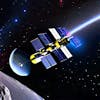S03E20: Extraterrestrial Voyages: Europa Clipper's Quest & Curiosity's Martian Chronicles

**Hosts:** Anna and the Astronomy Daily Team
---
**Episode Summary:**
Embark on a cosmic expedition with Anna and the Astronomy Daily Team as we navigate through the latest astronomical discoveries and the challenges of space exploration. In this...
**Hosts:** Anna and the Astronomy Daily Team
---
**Episode Summary:**
Embark on a cosmic expedition with Anna and the Astronomy Daily Team as we navigate through the latest astronomical discoveries and the challenges of space exploration. In this episode, we dive into the icy mysteries of Jupiter's moon Europa, unearth the secrets of ancient Martian rivers, and spotlight NASA's lunar ambitions. We also confront the growing concern of space debris and the thrilling possibility of detecting volcanic activity on distant exoplanets. Join us for a captivating journey that brings the wonders of the universe into sharper focus and closer to our earthly realm.
---
**Featured Topics:**
1. **Europa Clipper's Icy Odyssey:** Gear up for an inside look at NASA's Europa Clipper as it prepares for a groundbreaking journey to Jupiter's moon, seeking signs of life beneath its frozen crust.
2. **Martian Rivers Revisited:** Traverse the dry riverbeds of Mars with NASA's Curiosity rover, piecing together the planet's watery past and the enigmatic history etched into its landscape.
3. **Lunar Rovers Ready to Roll:** Discover how the Artemis program's lunar terrain vehicles will redefine moon exploration, offering astronauts unprecedented freedom and autonomy on the lunar surface.
4. **The Fallout of Space Debris:** Reflect on the tangible impact of space debris as we examine a close call in Florida, highlighting the urgency for innovative solutions to clean up our orbital backyard.
5. **Volcanoes in the Stars:** Peer into the potential of detecting volcanic activity on exoplanets, a pursuit that could reshape our understanding of geological processes in alien worlds.
---
**Additional Information:**
For those yearning for more celestial content, navigate to astronomydaily.io to explore in-depth articles, revisit past episodes, and subscribe to our newsletter for your daily dose of the cosmos. Engage with our stargazing community by following @astrodailypod on X and join the conversation that spans the universe.
---
**Closing Remarks:**
As we conclude today's stellar exploration, we thank you for your companionship on this interstellar voyage. The cosmos is vast and ever-evolving, and together, we'll continue to uncover its marvels. Until our next celestial encounter, this is Anna, wishing you clear skies and a heart full of wonder. Keep looking up, for the universe beckons.
---
**Host Sign-off:** Anna: "Thank you for tuning into Astronomy Daily. Until we traverse the stars together again, this is Anna, signing off. Dream big, fellow stargazers!
For more visit www.astronomydaily.io
---
📋 Episode Chapters
(00:00) Astronomy Daily is the podcast where we explore the latest developments in space exploration
(00:40) NASA's Europa Clipper is gearing up for an unparalleled voyage to Europa
(02:44) NASA's Curiosity rover explores ancient riverbed on Mars
(06:23) A piece of space debris crashed into a Florida home on March 8
(10:32) Thank you for listening to Astronomy daily podcast
Become a supporter of this podcast: https://www.spreaker.com/podcast/astronomy-daily-the-podcast--5648921/support.
AI Transcript
Astronomy Daily is the podcast where we explore the latest developments in space exploration
Anna: Welcome to Astronomy Daily, the podcast where we explore the latest developments in space exploration and astronomy. My name is Anna, and I'll be your guide. Today we will delve into the exciting world of Jupiter's moon Europa, ancient martian rivers, NASA's lunar endeavors, space debris impacts, and the potential to observe volcanoes on exoplanets. Join us as we journey through the cosmos, uncovering the wonders and challenges that lie in our universe's vast expanses. Stay tuned as we bring the frontiers of space a little closer to home.
NASA's Europa Clipper is gearing up for an unparalleled voyage to Europa
The astronomy Daily podcast NASA's Europa Clipper is gearing up for an unparalleled voyage to peel back the icy shrouds of Jupiter's moon Europa. The target? A tantalizing subsurface ocean that inflames our astrobiological curiosity. The odyssey that lies ahead for the spacecraft is a testament to human engineering and our insatiable quest to understand the cosmos. Braving a 1.6 billion mile journey, the Europa clipper has been meticulously forged to confront the relentless extremes of space, from the bone rattling vibrations on launch atop a SpaceX falcon heavy rocket to the dizzying temperature fluctuations and the formidable radiation belts of Jupiter. To ensure fitness for this interplanetary sprint, the spacecraft faced a litany of environmental trials that pushed it to its limits. Housed within the cavernous chambers of NASA's Jet propulsion Laboratory, the craft endured shudders and shocks that mimicked the traumas of launch and separation alongside bouts in a thermal vacuum chamber that emulated the bleak void of space. Rigorous shaking, acoustic barrages, and electromagnetic testing formed this harrowing gauntlet. However, Europa Clipper emerged with aplomb, ready to undertake its mission. With a scheduled launch window opening on October 10 of this year, this imposing craft will initially carve its path toward Mars to garner a gravitational slingshot maneuver back past Earth for a final terrestrial farewell and onward to the icy embrace of Europa. By 2030, the Europa clipper is poised to commence its swing sweep around Jupiter. Embarking on no less than 49 flybys of Europa, the spacecraft will dip within a mere 25 km from Europa's surface, wielding a sophisticated array of scientific instruments designed to dissect the enigma of this frozen world from afar. What we learned from the Europa Clipper mission could redefine our understanding of the potential for life in extraterrestrial oceans and forever alter the way we perceive our place in the universe.
NASA's Curiosity rover explores ancient riverbed on Mars
As NASA's curiosity rover trudges across the stark martian landscape, its wheels now trace the contours of what appears to be an ancient riverbed. The desiccated remnants of a once flowing martian river. The fascinating geological feature known as Geddes valis, reveals the legacy of liquid water that sculpted its path through Mount Sharp's foothills billions of years ago. As our interplanetary emissary delves deeper into this winding channel strewn with boulders and sediment, scientists back on Earth watch eagerly, hoping to unravel the mysteries of martian hydrology. Each pebble examined, each layer of sediment analyzed, contributes a vital piece to the grand puzzle of Mars climatic history. What we are witnessing is the rover acting as a time machine, offering us glimpses of an era when water flowed freely across the red planet's surface. It's an exploration that stretches beyond the bounds of Curiosity's initial two year mission. Now well into its 12th year, the rover continues to exceed expectations, tirelessly gathering data that might hint at former habitable conditions and perhaps the faint fossilized fingerprints of past martian life. Curiosity's journey up, uh, Mount Sharp is a silent testament to the winds of change that eroded this once majestic peak, layer by layer into the stratified canvas we see today. The rover's sojourn through Geddes Valis is not just a scientific endeavor. It is a poetic voyage across eons, reconnecting us with the natural forces that once shaped Mars into a world more like our own. As we follow Curiosity's tireless trek, let us marvel at the rover's resilience and the distant world it roams, reminding us that even amidst the barrenness of space, rivers, both literal and metaphorical, continue to flow. NASA's vision for the next era of moon exploration is crystallizing, with the selection of three stellar companies poised to steer the future of lunar mobility. Intuitive machines lunar outpost and Venturi astrolabe are at the forefront of engineering the Artemis program's lunar terrain vehicles, the linchpins that will extend the reach of astronauts exploring the moon's enigmatic southern polar region. These LTVs promise to revolutionize the way we traverse the alien landscapes of the moon, granting unprecedented freedom to those who boldly stand under Earth's silent companion. As the Artemis missions aim to establish a sustainable human presence, these rovers will not only carry astronauts over the undulating, crater pocked terrain, but will serve as robust platforms for science and discovery. What's more, they'll do it with an autonomy akin to that of robotic explorers on Mars, marauding the lunar dust both with and without the guiding hand of a human commander. Much like the storied moon buggies of the Apollo era, these vehicles echo the spirit of adventure. But they are imbued with the technological advancements of our time. The ability to operate uncrewed presents a tantalizing prospect that even in the absence of astronauts, the wheels of exploration will continue to turn, gathering valuable data and pushing the boundaries of our understanding as our gaze turns back to the moon. The Artemis LTV contracts are more than just an agreement for vehicles. They represent commitment and opportunity. Commitment to the exploration of our celestial neighbor and the opportunity to ignite a new era of discovery. With the envisaged launch of the Artemis V mission on the horizon, these rovers are the harbingers of a new dawn, where the moon becomes more than just a waypoint, but a place teeming with potential and ripe for exploration.
A piece of space debris crashed into a Florida home on March 8
Our skies are becoming increasingly cluttered, and the evidence landed quite literally in Alejandro Otero's home in Naples, Florida, on March 8. A cylindrical object weighing nearly two pounds crashed through his roof and floors, narrowly missing his son. The alien intruder, likely one of nine drained batteries jettisoned from the International Space Station and part of a japanese cargo pallet that reentered Earth's atmosphere earlier that very day. This extraordinary event may seem isolated, but it signifies a larger, more pressing issue. Space agencies around the globe are tasked with monitoring over 30,000 pieces of orbital debris. Yet countless smaller fragments evade their watchful eyes. The impact on Oteros residents underlines the unpredictable nature of space debris reentry, a ah, phenomenon not exclusive to Florida. Remember the chinese long March 5 B boosters and falling SpaceX rocket parts leaving their mark from the ivory coast to australian farms? With NASA officials collecting the debris for analysis, the boundaries between space exploration and earthly life blur. And while some call for sweeping the skies clean with nets, clawed robots, or lengthy tethers, the solution to this celestial littering seems as distant as the stars. The incident stands as a stark reminder that as our reach extends into the cosmos, Earth's orbit bears the brunt of our ambitious endeavors. The Astronomy daily podcast imagine a world orbiting a distant star, its land seething with volcanic activity. Magma chambers rupturing, ash clouds billowing, and gases painting the skies with telltale signs of their fiery origins. Could we, from our quiet corner of the cosmos, detect these tumultuous processes on an exoplanet light years away? It's not just a question for science fiction anymore. Recent studies, spearheaded by researchers at UC Riverside, teamed with experts from NASA's Goddard Space Flight center and more, are honing in on the atmospheric signals that betray the presence of volcanoes beyond our solar system. They've turned to legacy technology. Similar to the James Webb Space Telescope and the anticipation of future instruments such as the proposed lvoir observatory to discern what the dips and peaks in a distant world's light spectrum could tell us. Their work is premised on a fundamental what if an Earth like exoplanet had volcanoes pumping out gases such as sulfur dioxide and sulfate aerosols into its atmosphere? Using advanced simulation programs like the GOSCCM, these researchers mimic the ebb and flow of volcanic activity, injecting virtual sulfur dioxide every three months, akin, uh, to how you'd expect a persistent, fiery mountain to they carefully observed the impacts on oxygen's o, two ozone, and even water vapor spectral lines, witnessing as these lines danced and shifted in response to the volcanic mock up. For instance, ozone, a protective layer in our own stratosphere, seemed to dwindle amidst simulated eruptions due to a, uh, transformative reaction into sulfuric acid, only to show signs of recovery post eruptions and encouraging parallel to Earth's own response to cfcs. The ambition is clear to isolate clear cut spectrographic signatures that unmistakably indicate volcanoes are sculpting the landscapes of exoplanets. Even now, scientists estimate the observational endurance it might take for future, even more advanced telescopes to to catch these spectral lines in the act, ozone signals could beam back after a mere six hour focus on our space observatories, with water vapor being a more elusive quarry flirting with the edges of detectability. The research isn't just academic detecting these volcanic whispers could have profound implications for understanding whether distant worlds have the same geological vitality as Earth, or if they're dormant balls of rock. It could give us vital clues about the makeup, and perhaps even the habitability of these alien terrains. As we press our eyes to the cosmos, the specter of volcanoes on exoplanets looms larger with each study, lighting a path toward one day catching sight of these natural wonders at the edge of the universe.
Thank you for listening to Astronomy daily podcast
As we bring today's foray into the cosmos to a close, I'd like to extend a heartfelt thank you for joining us on Astronomy daily, the podcast our universe never ceases to amaze, and there's always more to uncover. To continue feeding your curiosity, and to stay on top of the latest space developments, please visit our website at astronomydaily.io There, you can explore the latest space news, listen to new episodes, sign up for our free daily newsletter, and revisit your favorite episodes from the past. Your support is our greatest motivator, and it fuels our mission to bring the universe a little closer to you one podcast at a time. Don't forget, the conversation doesn't end here. Connect with us on X, formerly Twitter, and continue the dialogue. Just search for AstroDailyPod and hit that follow button to make sure you're part of our community. We're looking forward to sharing the next discovery with you. Until next time, this is Anna saying bye bye. Keep your eyes on the skies and your heart filled with wonder. Clear skies and happy stargazing. The astronomy daily podcast.
New to Astronomy Daily - The Podcast?
Here are some great episodes to start with.














